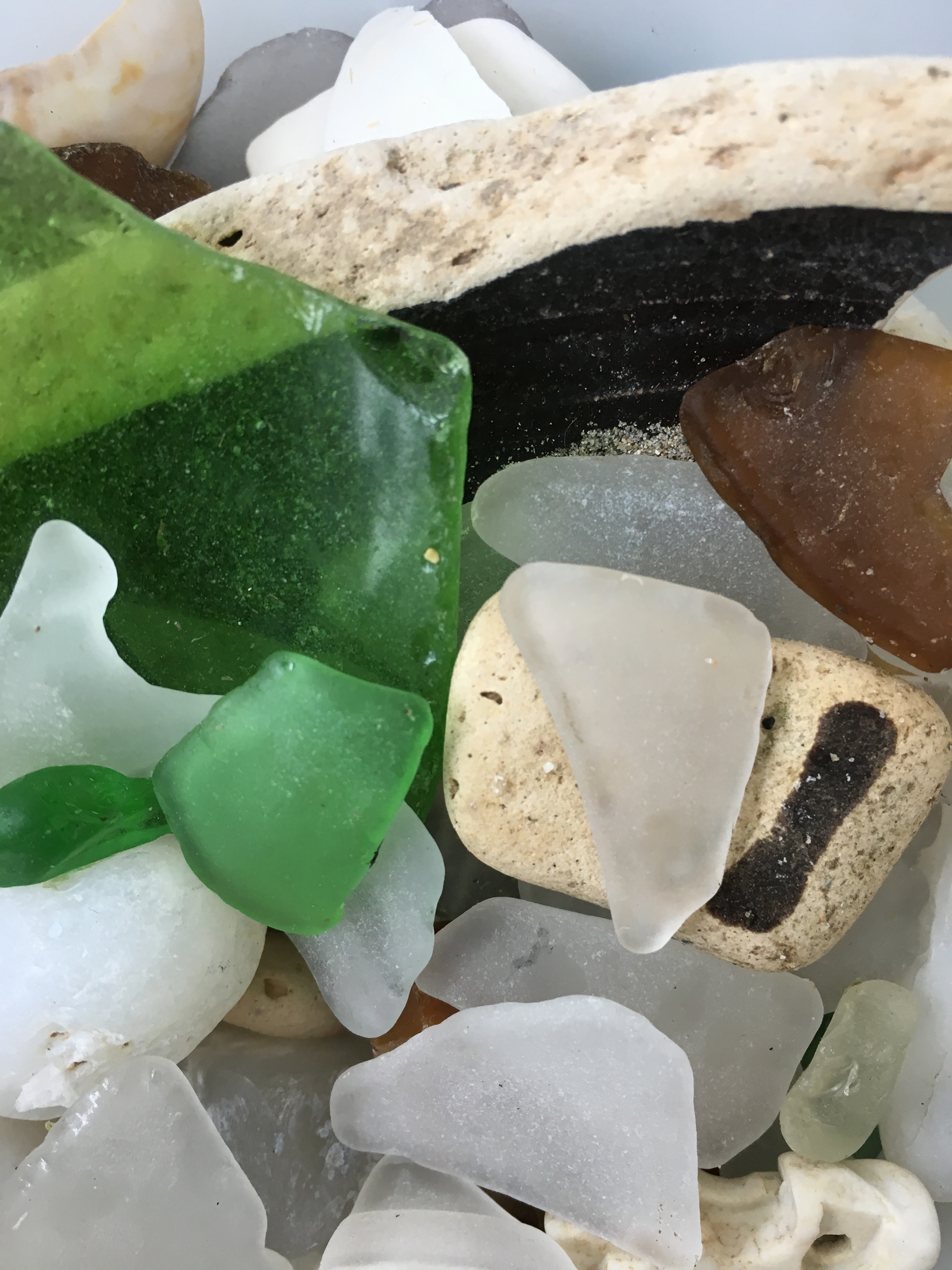Purple sea glass doesn’t come from purple glass. It comes from time: as the shards are worn down by waves and rocks, sharp edges dulled by sand and stone, the decades that the formerly-clear glass spends in the sunlight will lend a lavender hue to the manganese that, before World War I, was often added to glass to give it clarity. Other more common colors like brown and green have their own origin stories among sea glass collectors—each a combination of history, science, and myth. The oldest pieces of glass to be found are nearly black with an olive hue showing in the light, each an increasingly rare relic of the 19th century shipping trade, when iron slag was added to glass in order to strengthen hand-blown glass bottles set to cross the Atlantic.
It’s an odd activity, looking for sea glass: Letting your eyes pass over shell, sand, and rock in the pursuit of remnants of trash that was dumped unceremoniously into the ocean decades prior. On some stretches of coast adjacent to old dumps, glass has replaced sand altogether, as is the case at glass beach in Fort Bragg, Calif., which is a destination for glass hunters. Near where we live in Maine, there’s a beach that my daughter and I like to sneak onto (it’s private, but you can walk around the nearby pier and cross over a small creek at low tide) that has an impressive amount of sea glass, as well as pottery shards, and we’ve found glass of all colors there—purple, pink, green, blue, white, and more, sometimes in impressively large pieces, or the familiar ridges of a bottle neck. It adds a thrill to think of a purple piece as an archeological discovery, something has continually changed state for more than a century until finally being plucked off of the beach. The more prosaic story of beach glass is less romantic: it’s a long, damaging record of garbage dumped into the sea, a history highlighted by pieces of glass that still bear vintage logos of soda companies not from my grandparents’ youth, but from my own.
 Photo: Story Blackmore
Photo: Story BlackmoreBeach glass is a dwindling artifact of the anthropocene, with the colors that weren’t widely used having already become incredibly rare. Red sea glass, for example, nearly all originated from a number of limited runs of Schlitz beer sold in red bottles in the 1940s, ‘50s, and 60s, according to blogs like The Sea Glass Journal and the various guidebooks that trade in sea glass origin stories. The glass, made by Anchor Hocking, was colored with copper instead of the gold used in antique red glass. Cobalt blue glass, you’ll read, could be an old poison bottle—or a shard from a tub of Noxema or Vick’s VaporRub.
Instead of being dumped into the sea, today’s glass tends to be (hopefully) recycled, or piled into the earth with the rest of our trash. Eventually, all of the sea glass—first the black and red, and then all of the rest—will be gone, either picked up or ground back down into something like the sand that it was once made from.
If glass becomes precious by its mortality, there’s much less romance in the legacy of ocean plastic, of which there is no end in sight. Billions of pounds of plastic waste has washed into the seas, with ten metric tons of plastic making its way into the Pacific every day from the Los Angeles basin alone. There are uninhabited islands in the midst of the Pacific where the beaches are littered with bottles and bags and other garbage from afar; a massive gyre of garbage swirls away in the open ocean between Hawaii and California. Glass is an artifact; plastic is a wound.
This plastic will not turn into pretty colors, or bring delight to those to find it scattered across otherwise pristine beaches. And yet it has its own poetry: it will return to where it came. As the waste is broken down into smaller and smaller particles—into specks that, despite their diminutive size, will never decompose—they will be ingested by wildlife, especially fish and shellfish that filter seawater as they feed. Then, as we pull seafood out of the oceans and put it in our bodies, humans will bring the plastic we made, used, and then recklessly trashed back into our world. Most of the microscopic pieces of plastic a person inadvertently consumes every year by eating seafood passes right through, returning, perhaps to the seas. But a small amount—1 percent, according to a 2014 study—will end up lodged in human tissue, forever. It is an inefficient but, if nothing else, fitting means of keeping it out of the water and off of the beach.
Ingredients is a regular Popula column, in which we explore the things that go into other things in order to become the things that they are.






